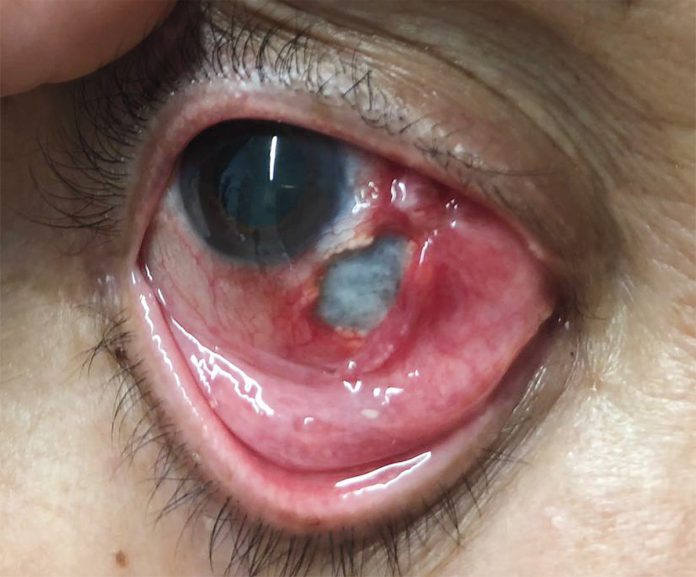The least common but the most dangerous type of scleritis.
A 73-year-old woman presented to the emergency department with a complaint of pain in her right eye for the past 1 month. The patient was a known case of seropositive erosive rheumatoid arthritis.
The patient had stopped taking her immunosuppressive drugs for the past 4 years before presenting with the eye complaints, and she had started taking homeopathic treatment.
On examination, the patient’s visual acuity in the right eye was 20/25. Slit-lamp examination revealed hyperemia, inflammation, and marked scleral thinning with exposure of the underlying choroid.
Serological investigations showed elevated levels of rheumatoid factor and erythrocyte sedimentation rate. The test was negative for antineutrophil cytoplasmic antibodies.
The patient was diagnosed with necrotizing anterior scleritis with inflammation.
The patient was started on intravenous glucocorticoids and cyclophosphamide. Surgery was performed to repair the scleral with a scleral graft and amniotic membrane transplantation. A conjunctival autograft obtained from the same eye was also performed.
The surgery was uneventful, and so was the post-surgical period. The patient completed a tapered oral glucocorticoid course, and immunosuppressive therapy was switched to oral methotrexate.
At the 3-month follow-up visit, the patient had substantially improved. The ocular pain and inflammation had resolved, and her vision was preserved.
Necrotizing anterior scleritis with inflammation usually affects middle-aged women suffering from serious systemic collagen vascular disorders, such as rheumatoid arthritis. Patients usually present with severe pain. The damage to the sclera is often marked.
It is the most severe form of scleritis, which can have vision-threatening complications and even permanent loss of vision
It is imperative to diagnose and treat it promptly. The diagnosis of scleritis is clinical. Lab tests are done for the associated connective tissue disorder.
Systemic steroids and immunosuppressive drugs are the mainstays of medical treatment. NSAIDs are given for pain and inflammation. Areas with imminent scleral perforation warrant surgical intervention.
References:
Natalia Lorenzana Blanco, M. a. (2020, November 05). Necrotizing Scleritis. Retrieved from The New England Journal of Medicine: https://www.nejm.org/doi/full/10.1056/NEJMicm2004836
Lawuyi LE, Gurbaxani A. Refractory necrotizing scleritis successfully treated with adalimumab. J Ophthalmic Inflamm Infect. 2016;6(1):37. DOI:10.1186/s12348-016-0107-y
Karamursel et al. Evaluation of Patients with Scleritis for Systemic Disease. Ophthalmology 2004; 111: 501-506.




